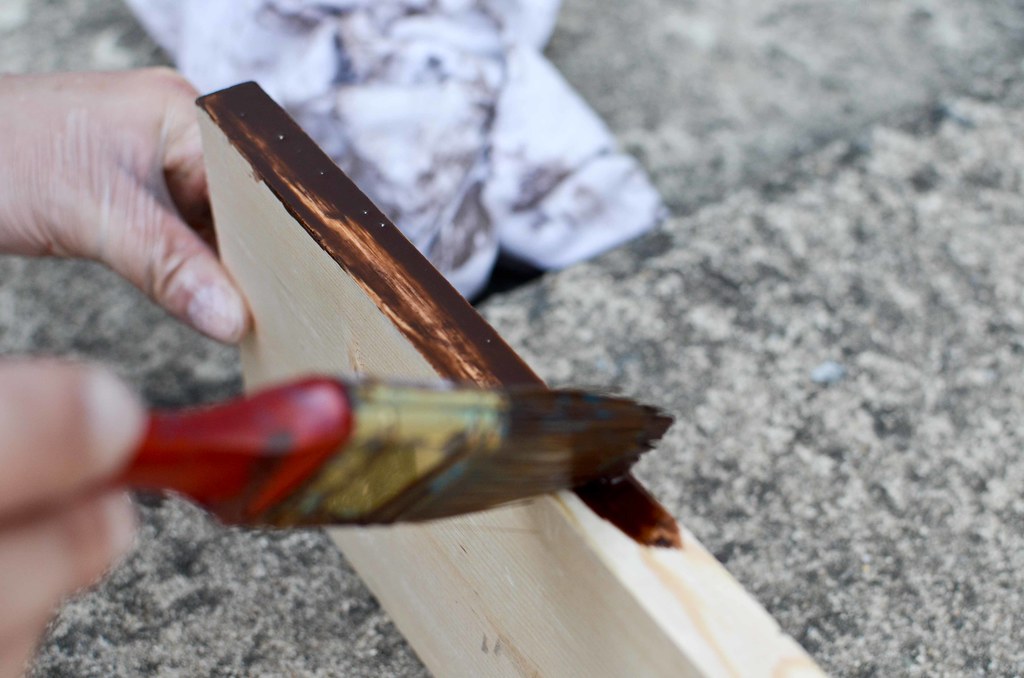When it comes to applying water-based stain, think of it as painting a canvas with precision.
But before you immerse yourself into this artistic process, remember that an important step lies in the preparation of your wood surface.
Yet, there’s more to uncover beyond just the basics.
By understanding the nuances of application techniques and mastering the art of achieving a perfect finish, you can elevate your staining game to a whole new level.
Preparing the Wood Surface
When preparing the wood surface for applying water-based stain, make sure you fill in any cracks, seams, and holes with stainable wood filler to achieve a smooth, flawless finish. This step is important as it guarantees that the stain will be applied evenly without any interruptions on the surface.
After filling in the imperfections, sand the wood following the direction of the grain using an appropriate grit sanding pad. This process helps in promoting better stain absorption and a more uniform finish.
Before proceeding with the staining process, it’s advisable to apply a pre-stain wood conditioner. This conditioner not only enhances the color of the wood but also helps in preventing blotchiness in the final finish.
Experiment with different finishes and application methods to determine the most effective technique for your specific wood project.
Remember to follow the manufacturer’s instructions carefully for the proper application of the pre-stain wood conditioner to achieve the best results.
Applying Wood Conditioner
Before proceeding with the application of wood conditioner, make sure that you have thoroughly stirred the product to achieve the proper consistency.
To begin, apply the wood conditioner liberally using a nylon brush or a clean cloth, ensuring even coverage over the entire surface of the wood.
Allow the conditioner to penetrate the wood’s surface for a few minutes to enhance the absorption of the stain.
Once the conditioner has had time to work its magic, gently wipe off any excess product to prevent over-saturation.
It’s important to let the conditioned wood dry completely before moving on to the water-based stain application.
Once dry, lightly sand the surface to create a smooth and uniform base for the stain, ensuring best results.
Staining With Water-Based Stain
After properly conditioning the wood surface, the next step is to apply the water-based stain for a quick and efficient finishing process.
Water-based stain is a fantastic choice for your woodworking projects due to its quick drying nature, making same-day staining and top coating possible.
Its low odor makes it perfect for indoor use, ensuring a pleasant working environment.
Cleanup is a breeze with water-based stain; simply use soap and water, eliminating the need for harsh chemicals. This type of stain is sensitive-friendly, ideal for individuals who may be sensitive to strong odors during application.
The efficient application of water-based stain streamlines the staining process, allowing for fast application and saving you time on your projects. With its quick drying time, low odor, easy cleanup, and sensitive-friendly properties, water-based stain is a top choice for a smooth and effective staining experience.
Sealing the Stained Wood
Have you considered how sealing the stained wood with a water-based top coat can enhance and protect the finish of your woodworking project? Applying a water-based top coat is important for protecting the wood from wear and tear while providing a clear finish that won’t yellow over time.
When it comes to application, you have a few options such as using a foam brush, a paint pad, or spraying for larger surfaces.
To make sure maximum durability, consider applying multiple coats of the water-based top coat. Between each coat, buffing the surface gently can help achieve a smooth and professional finish.
This process not only enhances the appearance of your project but also serves as a protective barrier against daily use and environmental factors.
By sealing the stained wood with a water-based top coat, you aren’t only adding beauty but also longevity to your woodworking creation.
Tips for Successful Staining
For successful staining, make thorough stirring of the water-based stain to achieve consistent color distribution. When applying the stain, opt for a foam brush or latex paint pad to guarantee even coverage.
Work in manageable sections to prevent the stain from drying before you can wipe off any excess with the wood grain.
It’s essential to apply the stain in a wet and liberal manner for the best results.
Additionally, consider using a primer on heavily grained wood to enhance the absorption of the stain and promote color consistency throughout the project.
Conclusion
To sum up, properly preparing the wood surface, applying a wood conditioner, and using the right techniques for staining with water-based stain are key to achieving a flawless finish.
Remember to seal the stained wood for long-lasting protection.
Follow these tips for successful staining to guarantee a professional-looking result that highlights the natural beauty of the wood.
With water-based stain, you can enjoy the benefits of quick drying, easy cleanup, and efficient application for a job well done.


Leave a Reply